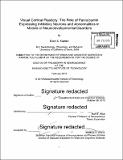| dc.contributor.advisor | Mark F. Bear. | en_US |
| dc.contributor.author | Kaplan, Eitan S | en_US |
| dc.contributor.other | Massachusetts Institute of Technology. Department of Brain and Cognitive Sciences. | en_US |
| dc.date.accessioned | 2016-06-22T17:47:35Z | |
| dc.date.available | 2016-06-22T17:47:35Z | |
| dc.date.copyright | 2016 | en_US |
| dc.date.issued | 2016 | en_US |
| dc.identifier.uri | http://hdl.handle.net/1721.1/103210 | |
| dc.description | Thesis: Ph. D. in Neuroscience, Massachusetts Institute of Technology, Department of Brain and Cognitive Sciences, 2016. | en_US |
| dc.description | Cataloged from PDF version of thesis. Vita. | en_US |
| dc.description | Includes bibliographical references (pages 121-134). | en_US |
| dc.description.abstract | The roles played by cortical inhibitory neurons in experience-dependent plasticity and learning are not well understood. Here we evaluate the participation of parvalbumin-expressing (PV+) GABAergic neurons in two forms of experience-dependent modification of primary visual cortex (V1) in adult mice: ocular dominance (OD) plasticity resulting from monocular deprivation and stimulus-selective response potentiation (SRP) resulting from supplemental visual experience. These two forms of plasticity are triggered by different events but lead to a similar increase in visual cortical response. Both also require the NMDA class of glutamate receptor (NMDAR). However, we find that PV+ inhibitory neurons in V1 play a critical role in the expression of SRP and its behavioral correlate of familiarity recognition, but not in the expression of OD plasticity. Furthermore, NMDARs expressed within PV+ cells play a critical role in SRP, but not in the induction or expression of adult OD plasticity. We also explore the use of visual cortical plasticity paradigms to better understand the function of proteins implicated in autism spectrum disorders (ASDs) and schizophrenia. We find that NMDAR-dependent long-term depression (LTD) and deprived-eye depression in layer 4 of V1 require metabotropic glutamate receptor 5 (mGluR5) signaling during postnatal development. Additionally, schizophrenia-associated protein neurogranin overexpression in V1 disrupts juvenile ocular dominance plasticity. Finally, we evaluate SRP in two models of ASDs associated with excitatory/ inhibitory imbalance: Rett syndrome (RTT) and tuberous sclerosis complex (TSC). Surprisingly, mouse models of RTT and TSC exhibit abnormal SRP phenotypes, but in opposite directions. | en_US |
| dc.description.statementofresponsibility | by Eitan S. Kaplan. | en_US |
| dc.format.extent | 134 pages | en_US |
| dc.language.iso | eng | en_US |
| dc.publisher | Massachusetts Institute of Technology | en_US |
| dc.rights | M.I.T. theses are protected by copyright. They may be viewed from this source for any purpose, but reproduction or distribution in any format is prohibited without written permission. See provided URL for inquiries about permission. | en_US |
| dc.rights.uri | http://dspace.mit.edu/handle/1721.1/7582 | en_US |
| dc.subject | Brain and Cognitive Sciences. | en_US |
| dc.title | Visual cortical plasticity : the role of parvalbumin expressing inhibitory neurons and abnormalities in models of neurodevelopmental disorders | en_US |
| dc.type | Thesis | en_US |
| dc.description.degree | Ph. D. in Neuroscience | en_US |
| dc.contributor.department | Massachusetts Institute of Technology. Department of Brain and Cognitive Sciences | |
| dc.identifier.oclc | 951475265 | en_US |
